This code was written to solve a problem I had debugging and testing an application which processed data from sensors attached to The Things Network(TTN) and I figured others might find it useful.
As part of my series of TTN projects I wanted to verify that the data from a number of LoRaWAN sensors connected to TTN was reasonable and complete. I’m familiar with Microsoft SQL Server so I built a .Net Core console application which uses the TTN Message Queue Telemetry Transport(MQTT) Data API (so it can run alongside my existing TTN integration) to receive messages from the all devices in a TTN application and store them in a database for post processing.
The console application uses MQTTNet to connect to TTN MQTT Data API. It subscribes to an application device uplink topic, then uses a combination of Stackoverflow Dapper with Microsoft SQL Server tables and stored procedures to store the device data points. I re-generated the classes I had used in my other projects, added any obvious missing fields and fine tuned the data types by delving into the TTN V2 GO code.
The core of the application is in the MQTTNet application message received handler.
private static void MqttClient_ApplicationMessageReceived(MqttApplicationMessageReceivedEventArgs e)
{
PayloadUplinkV2 payload;
log.InfoFormat($"Receive Start Topic:{e.ApplicationMessage.Topic}");
string connectionString = configuration.GetSection("TTNDatabase").Value;
try
{
payload = JsonConvert.DeserializeObject<PayloadUplinkV2>(e.ApplicationMessage.ConvertPayloadToString());
}
catch (Exception ex)
{
log.Error("DeserializeObject failed", ex);
return;
}
try
{
if (payload.PayloadFields != null)
{
var parameters = new DynamicParameters();
EnumerateChildren(parameters, payload.PayloadFields);
log.Debug($"Parameters:{parameters.ParameterNames.Aggregate((i, j) => i + ',' + j)}");
foreach (string storedProcedure in storedProcedureMappings.Keys)
{
if (Enumerable.SequenceEqual(parameters.ParameterNames, storedProcedureMappings[storedProcedure].Split(',', StringSplitOptions.RemoveEmptyEntries), StringComparer.InvariantCultureIgnoreCase))
{
log.Info($"Payload fields processing with:{storedProcedure}");
using (SqlConnection db = new SqlConnection(connectionString))
{
parameters.Add("@ReceivedAtUtc", payload.Metadata.ReceivedAtUtc);
parameters.Add("@DeviceID", payload.DeviceId);
parameters.Add("@DeviceEui", payload.DeviceEui);
parameters.Add("@ApplicationID", payload.ApplicationId);
parameters.Add("@IsConfirmed", payload.IsConfirmed);
parameters.Add("@IsRetry", payload.IsRetry);
parameters.Add("@Port", payload.Port);
db.Execute(sql: storedProcedure, param: parameters, commandType: CommandType.StoredProcedure);
}
}
}
}
else
{
foreach (string storedProcedure in storedProcedureMappings.Keys)
{
if (string.Compare(storedProcedureMappings[storedProcedure], "payload_raw", true) == 0)
{
log.Info($"Payload raw processing with:{storedProcedure}");
using (SqlConnection db = new SqlConnection(connectionString))
{
var parameters = new DynamicParameters();
parameters.Add("@ReceivedAtUtc", payload.Metadata.ReceivedAtUtc);
parameters.Add("@DeviceID", payload.DeviceId);
parameters.Add("@DeviceEui", payload.DeviceEui);
parameters.Add("@ApplicationID", payload.ApplicationId);
parameters.Add("@IsConfirmed", payload.IsConfirmed);
parameters.Add("@IsRetry", payload.IsRetry);
parameters.Add("@Port", payload.Port);
parameters.Add("@Payload", payload.PayloadRaw);
db.Execute(sql: storedProcedure, param: parameters, commandType: CommandType.StoredProcedure);
}
}
}
}
}
catch (Exception ex)
{
log.Error("Message processing failed", ex);
}
}
For messages with payload fields the code attempts to match the list of field names (there maybe more than one match) with the parameter list for stored procedures in the AppSettings.json file. The Enumerable.SequenceEqual uses a case insensitive comparison but order is important. I did consider sorting the two lists of parameters but wasn’t certain the added complexity was worth it.
{
"TTNDatabase": "Server=DESKTOP-1234567;Initial Catalog=Rak7200TrackerTest;Persist Security Info=False;User ID=TopSecret;Password=TopSecret;Connection Timeout=30",
"MqttServer": "eu.thethings.network",
"MqttPassword": "ttn-account-TopSecret",
"ApplicationId": "rak811wisnodetest",
"MqttClientId": "TTNSQLClient",
"StoredProcedureMappings": {
"EnvironmentalSensorProcess": "relative_humidity_0,temperature_0",
"PayloadRawProcess": "payload_raw",
"WeatherSensorProcess": "barometric_pressure_0,temperature_0",
"PositionReportProcess": "accelerometer_3x,accelerometer_3y,accelerometer_3z,analog_in_10,analog_in_11,analog_in_8,analog_in_9,gps_1altitude,gps_1latitude,gps_1longitude,gyrometer_5x,gyrometer_5y,gyrometer_5z"
}
}
To reduce the scope for mistakes (especially with longer parameter lists) I usually copy them from the Log4Net RollingFileAppender file or ManagedColoredConsoleAppender console output.
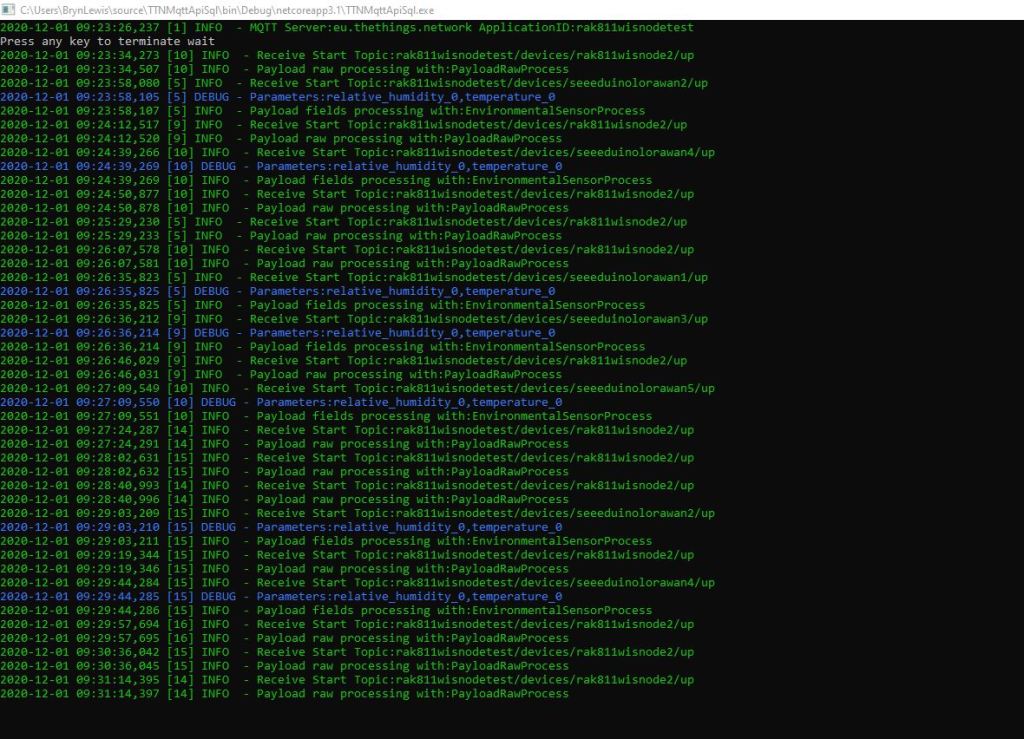
I created a database table to store the temperature and humidity values.
CREATE TABLE [dbo].[EnvironmentalSensorReport](
[WeatherSensorReportUID] [UNIQUEIDENTIFIER] NOT NULL,
[ReceivedAtUtC] [DATETIME] NOT NULL,
[DeviceID] [NVARCHAR](32) NOT NULL,
[DeviceEui] [NVARCHAR](32) NOT NULL,
[ApplicationID] [NVARCHAR](32) NOT NULL,
[IsConfirmed] [BIT] NOT NULL,
[IsRetry] [BIT] NOT NULL,
[Port] [SMALLINT] NOT NULL,
[Temperature] [FLOAT] NOT NULL,
[Humidity] [FLOAT] NOT NULL,
CONSTRAINT [PK_EnvironmentalSensorReport] PRIMARY KEY CLUSTERED
(
[WeatherSensorReportUID] ASC
)WITH (PAD_INDEX = OFF, STATISTICS_NORECOMPUTE = OFF, IGNORE_DUP_KEY = OFF, ALLOW_ROW_LOCKS = ON, ALLOW_PAGE_LOCKS = ON) ON [PRIMARY]
) ON [PRIMARY]
GO
ALTER TABLE [dbo].[EnvironmentalSensorReport] ADD CONSTRAINT [DF_EnvironmentalSensorReport_EnvironmentalSensorReporttUID] DEFAULT (NEWID()) FOR [WeatherSensorReportUID]
GO
The stored procedure must have the parameters @ReceivedAtUtc, @DeviceID, @DeviceEui, @ApplicationID, @IsRetry, @IsConfirmed and @Port. In this example the payload specific fields generated by the Low Power Protocol(LPP) decoder are @Temperature_0 and @relative_humidity_0
CREATE PROCEDURE [dbo].[EnvironmentalSensorProcess]
@ReceivedAtUtc AS DATETIME,
@DeviceID AS NVARCHAR(32),
@DeviceEui AS NVARCHAR(32),
@ApplicationID AS NVARCHAR(32),
@IsRetry AS BIT,
@IsConfirmed AS BIT,
@Port AS SMALLINT,
@Temperature_0 AS FLOAT,
@relative_humidity_0 AS FLOAT
AS
BEGIN
SET NOCOUNT ON;
INSERT INTO [dbo].[EnvironmentalSensorReport]
([PositionReportUID]
.[ReceivedAtUtc]
,[DeviceID]
,[DeviceEui]
,[ApplicationID]
,[IsConfirmed]
,[IsRetry]
,[Port]
,Temperature
,Humidity)
VALUES
(
@ReceivedAtUtc,
@DeviceID,
@DeviceEui,
@ApplicationID,
@IsConfirmed,
@IsRetry,
@port,
@Temperature_0,
@relative_humidity_0)
END
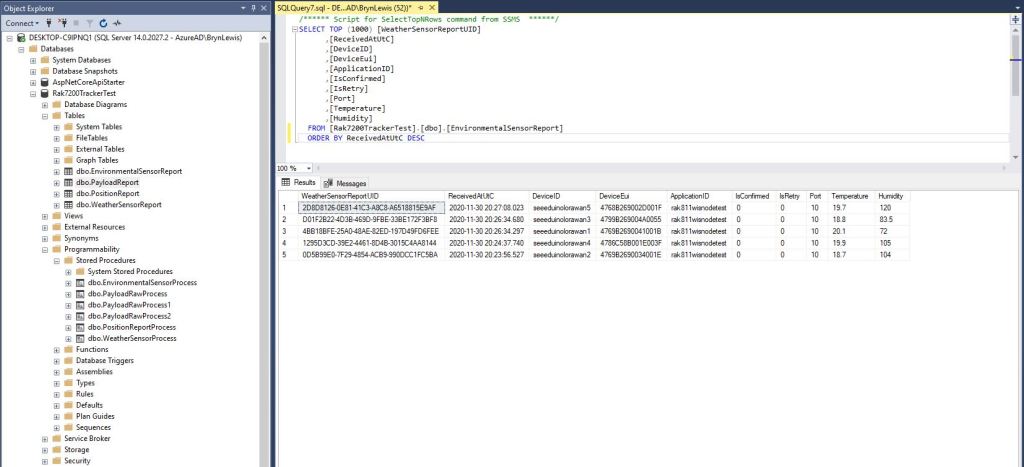
To store more complex nest payload fields (e.g. latitude, longitude and altitude values), I flattened the the hierarchy.
private static void EnumerateChildren(DynamicParameters parameters, JToken token, string prefix ="")
{
if (token is JProperty)
if (token.First is JValue)
{
JProperty property = (JProperty)token;
parameters.Add($"@{prefix}{property.Name}", property.Value.ToString());
}
else
{
JProperty property = (JProperty)token;
prefix += property.Name;
}
foreach (JToken token2 in token.Children())
{
EnumerateChildren(parameters,token2, prefix);
}
}
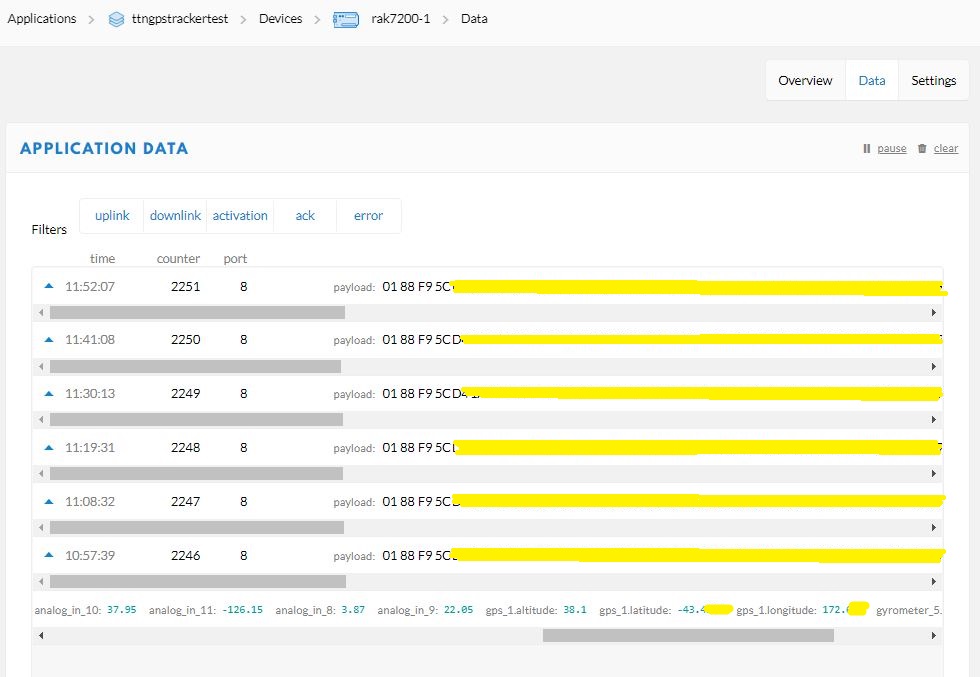
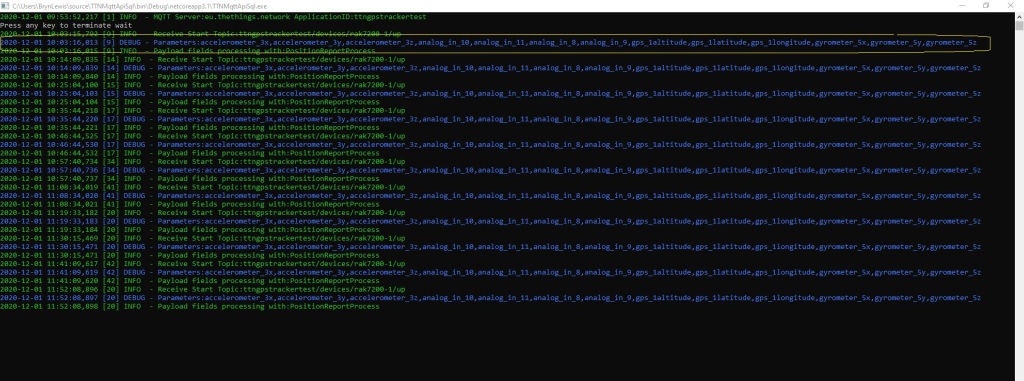
CREATE TABLE [dbo].[PositionReport](
[PositionReportUID] [UNIQUEIDENTIFIER] NOT NULL,
[ReceivedAtUtC] [DATETIME] NOT NULL,
[DeviceID] [NVARCHAR](32) NOT NULL,
[DeviceEui] [NVARCHAR](32) NOT NULL,
[ApplicationID] [NVARCHAR](32) NOT NULL,
[IsConfirmed] [BIT] NOT NULL,
[IsRetry] [BIT] NOT NULL,
[Port] [SMALLINT] NOT NULL,
[Latitude] [FLOAT] NOT NULL,
[Longitude] [FLOAT] NOT NULL,
[Altitude] [FLOAT] NOT NULL,
CONSTRAINT [PK_PositionReport] PRIMARY KEY CLUSTERED
(
[PositionReportUID] ASC
)WITH (PAD_INDEX = OFF, STATISTICS_NORECOMPUTE = OFF, IGNORE_DUP_KEY = OFF, ALLOW_ROW_LOCKS = ON, ALLOW_PAGE_LOCKS = ON) ON [PRIMARY]
) ON [PRIMARY]
GO
I created a database table to store values of only the fields I cared about.
CREATE PROCEDURE [dbo].[PositionReportProcess]
@ReceivedAtUtc AS DATETIME,
@DeviceID AS NVARCHAR(32),
@DeviceEui AS NVARCHAR(32),
@ApplicationID AS NVARCHAR(32),
@IsRetry AS Bit,
@IsConfirmed AS BIT,
@Port AS SMALLINT,
@accelerometer_3x AS FLOAT,
@accelerometer_3y AS FLOAT,
@accelerometer_3z AS FLOAT,
@analog_in_8 AS FLOAT,
@analog_in_9 AS FLOAT,
@analog_in_10 AS FLOAT,
@analog_in_11 AS FLOAT,
@gps_1Latitude AS FLOAT,
@gps_1Longitude AS FLOAT,
@gps_1Altitude AS FLOAT,
@gyrometer_5x AS FLOAT,
@gyrometer_5y AS FLOAT,
@gyrometer_5z AS FLOAT
AS
BEGIN
SET NOCOUNT ON;
INSERT INTO [dbo].[PositionReport]
([PositionReportUID]
.[ReceivedAtUtc]
,[DeviceID]
,[DeviceEui]
,[ApplicationID]
,[IsConfirmed]
,[IsRetry]
,[Port]
,Latitude
,Longitude
,Altitude)
VALUES
(
@ReceivedAtUtc,
@DeviceID,
@DeviceEui,
@ApplicationID,
@IsConfirmed,
@IsRetry,
@port,
@gps_1Latitude,
@gps_1Longitude,
@gps_1Altitude)
END
The stored procedure for storing the GPS tracker payload has to have parameters matching each payload field but some of the fields are not used.
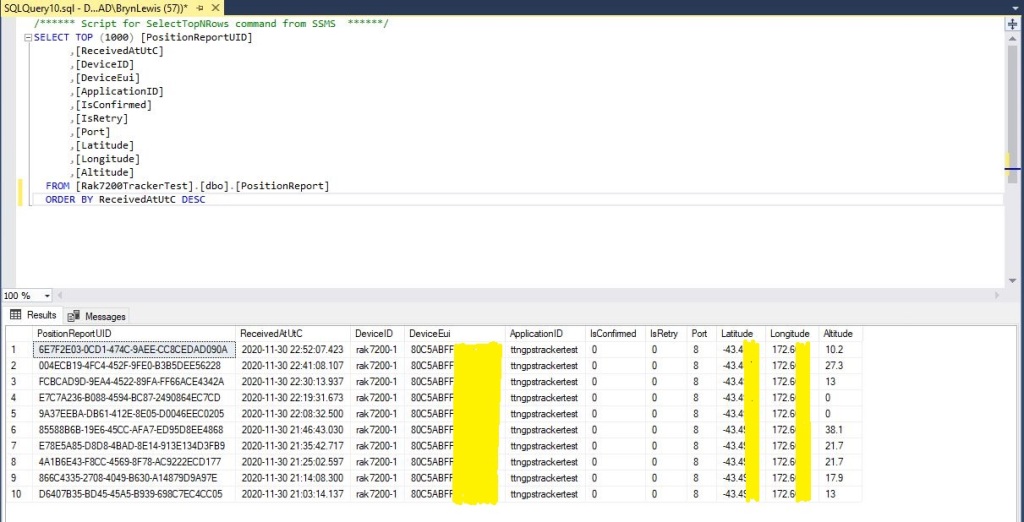
For uplink messages with no payload fields the message processor looks for a stored procedure with a single parameter called “payload_raw”.(there maybe more than one match)
CREATE TABLE [dbo].[PayloadReport](
[PayloadReportUID] [UNIQUEIDENTIFIER] NOT NULL,
[ReceivedAtUtC] [DATETIME] NOT NULL,
[DeviceID] [NVARCHAR](32) NOT NULL,
[DeviceEui] [NVARCHAR](32) NOT NULL,
[ApplicationID] [NVARCHAR](32) NOT NULL,
[IsConfirmed] [BIT] NOT NULL,
[IsRetry] [BIT] NOT NULL,
[Port] [SMALLINT] NOT NULL,
[Payload] [NVARCHAR](128) NOT NULL,
CONSTRAINT [PK_PayloadReport] PRIMARY KEY CLUSTERED
(
[PayloadReportUID] ASC
)WITH (PAD_INDEX = OFF, STATISTICS_NORECOMPUTE = OFF, IGNORE_DUP_KEY = OFF, ALLOW_ROW_LOCKS = ON, ALLOW_PAGE_LOCKS = ON) ON [PRIMARY]
) ON [PRIMARY]
GO
ALTER TABLE [dbo].[PayloadReport] ADD CONSTRAINT [DF_PayloadReport_PositionReportUID] DEFAULT (NEWID()) FOR [PayloadReportUID]
GO
ALTER PROCEDURE [dbo].[PayloadRawProcess]
@ReceivedAtUtc AS DATETIME,
@DeviceID AS NVARCHAR(32),
@DeviceEui AS NVARCHAR(32),
@ApplicationID AS NVARCHAR(32),
@IsRetry AS Bit,
@IsConfirmed AS BIT,
@Port AS SMALLINT,
@Payload AS NVARCHAR(128)
AS
BEGIN
SET NOCOUNT ON;
INSERT INTO [dbo].[PayloadReport]
([PositionReportUID]
.[ReceivedAtUtc]
,[DeviceID]
,[DeviceEui]
,[ApplicationID]
,[IsConfirmed]
,[IsRetry]
,[Port]
,[Payload])
VALUES(@ReceivedAtUtc,
@DeviceID,
@DeviceEui,
@ApplicationID,
@IsConfirmed,
@IsRetry,
@port,
@Payload)
END
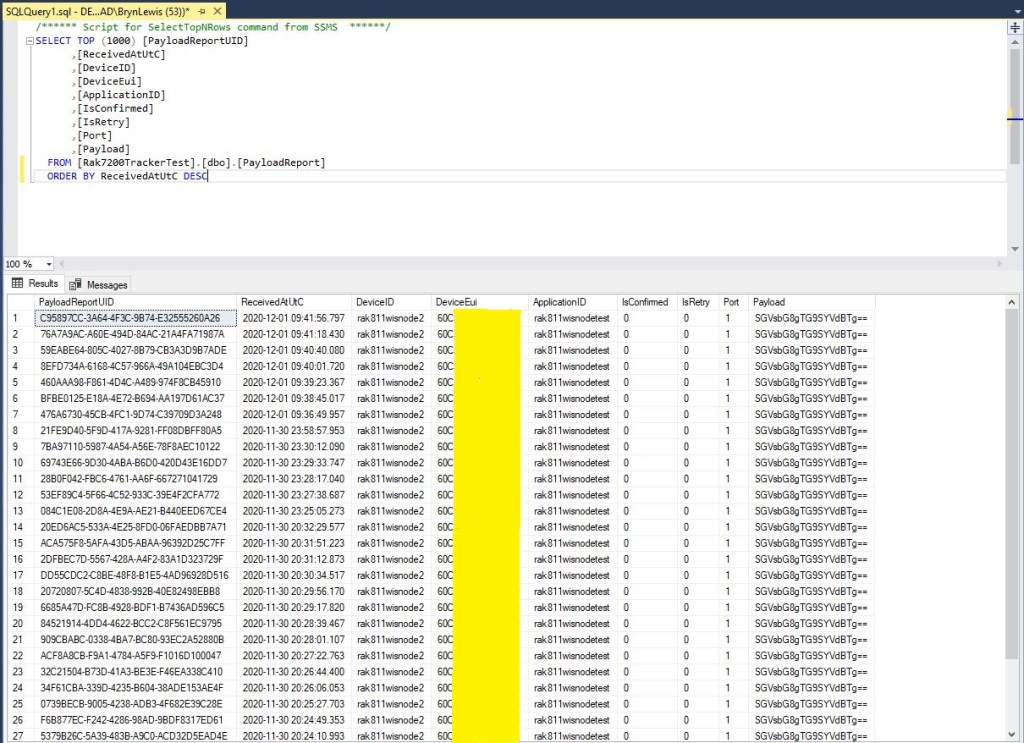
Initially the application just used Console.Writeline for logging, then I added Log4Net because it would be useful to persist information about failures and so I could copy n paste parameter lists to the appSettings.json file.
To make the application more robust adding a retries with the Enterprise Library Transient Fault Handling and Configuration blocks or Polly on the Dapper Execute would be a good idea. It also would take much work to get the application to run in Microsoft Azure as a “headless” webapp.
Dapper supports a number of database platforms so in theory this application (with a little bit of effort) should be platform portable.